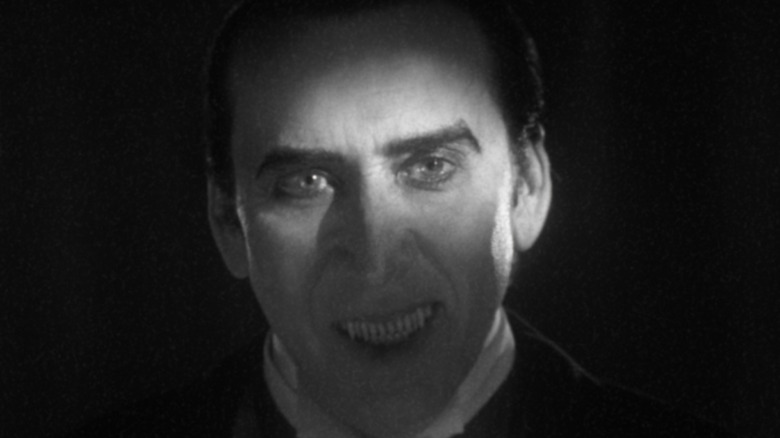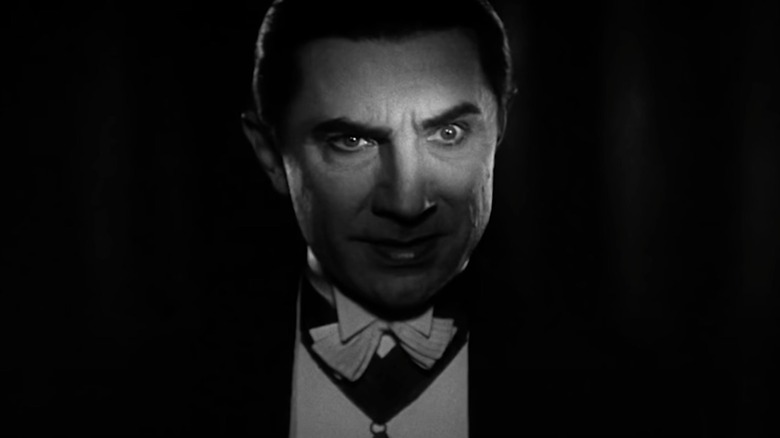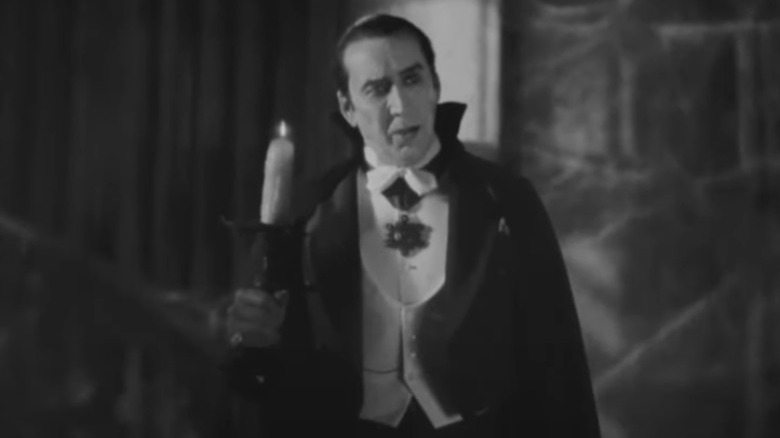Renfield's Black & White Dracula Prologue Was Much Harder To Pull Off Than It Seems
Inevitable comparisons are going be made between Bela Lugosi's classic Universal monster in Tod Browning's 1931 "Dracula" and Nicolas Cage's homage to the character in the new action comedy "Renfield," especially when director Chris McKay refers to the film as a "quasi-sequel" to the original. McKay's version certainly takes liberties with the material, catching up with Renfield (Nicholas Hoult) 90 years after Browning's masterpiece. Renfield realizes he's been in an extremely lengthy toxic relationship with his master while he sits in on group therapy sessions looking for potential victims. The abuse that Renfield suffers dates all the way back to their original meeting, prompting McKay and writers Robert Kirkman and Ryan Ridley to return to the scene of the crime in the opening prologue for "Renfield."
McKay and his team came up with the idea to essentially replace Lugosi and the original actor to play Renfield, Dwight Frye, with Cage and Hoult and insert them both into the original 1931 footage. The decision to recreate some of the more memorable moments in "Dracula" works to introduce audiences to Renfield's dysfunctional connection to Dracula and to pay tribute to the legacy that's come before. Due to limits in time and budgetary constraints, the prologue proved to be a much more difficult task than McKay and his collaborators expected. Originally, "Renfield" was also going to incorporate footage from other Hammer classics of the era and Frank Langella's indelible 1979 performance as the Count, which Cage also took inspiration from. When all of this proved too complicated, the decision was made to focus on Browning's version alone, and the entire crew went above and beyond to ensure that the sequence looked as authentic as possible.
An incredible attention to detail
Recreating and matching footage that's over 90 years old proved to be incredibly difficult due to a lack of specific information about the logistics and equipment that was implemented and used on set when Lugosi and Frye filmed the original. McKay heavily relied on second unit director and visual effects supervisor James E. Price to do the homework that would help them line up the camera positions, lighting, and the original camera lenses used back then and duplicate it in the present day. "I searched high and low to find out as much as I could about what kinds of lenses and film stocks they used back then," Price explained to IndieWire. He continued:
"There's not a lot of information available, but we were able to estimate knowing the heights of the actors and the approximate size of props and furniture in the room. From that, we could reverse engineer what the focal length of the shot might have been."
Figuring out the exact height of Lugosi and Frye before shooting already shows the dedication the "Renfield" had to get the prologue right. Interestingly, Lugosi (6'1") is listed as only being an inch taller than Cage (6'0"), whereas Hoult (6'3") is quite a notch taller than Frye (5'7") was at the time. After reverse engineering the shots from "Dracula," Price and McKay selected the iconic images they wanted and imported them into the computer to be able to precisely duplicate the camera movements over multiple takes.
In the spirit of preservation, Universal created a new 4k master of Browning's original "Dracula" that, presumably, would have helped Price and McKay in their endeavor, but the better image quality just ended up highlighting the differences in each shot, a consistency problem that was common in the early days of filmmaking.
Being faithful to the source
Looking at "Dracula" today, the overall look adds to the atmosphere. For Price, the constant changes in contrast and grain just created another challenge. As told to Indiewire:
"The amount of softness or sharpness changed from shot to shot, so we had a question to answer. Do we match every shot faithfully or to try to make it feel like more of a whole? In the end, we did a little bit of both. If it was a run of shots that were meant to be together, we made the grain and contrast consistent, if they were different scenes, we just let them be."
In the midst of a modern, big-budget production, it's a bold decision to commit to a black-and-white introduction, and McKay also worked with colorist Dave Cole to get the right look they had been searching for. Together, they "de-noised" the footage of the 1931 "Dracula" to match the more muted images found in the original. "The old look is more silvery and unique, and the backgrounds go out of focus really fast with the old lenses and the way the film stocks worked," explained McKay.
Originally, a Mitchell NC Standard 35mm Camera was used to shoot "Dracula." For another added bit of film history trivia, the actual #257 camera was also used on "Frankenstein," "Pinocchio," and "Fantasia." For Price, recreating what a nearly century-old piece of machinery captured took a lot of tinkering with the modern cameras used today. "Lenses today capture so much extra detail," he said. "We did a lot of experiments backing off on the detail level to make sure the images matched a traditional Hollywood movie of that era."
Check out some of the prologue footage in this TV spot to see if all of their efforts were justified.


